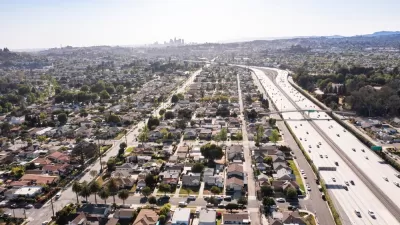Jeremy Rosenberg continues his fascinating series on the laws that shaped Los Angeles with a look at the local, and national, impact of the 1934 National Housing Act on residential development patterns.
In a prior article, Rosenberg examined whether Thomas Jefferson was to blame for L.A.'s sprawl. In this piece, he focuses his attention on the 32nd President.
The Federal Housing Administration (FHA) was created in 1934 by President Franklin Delano Roosevelt and his administration to help the country climb out of the Great Depression by stabilizing the mortgage market. "But, as H. Pike Oliver [senior lecturer and director of undergraduate studies at Cornell University's College of Architecture, Art & Planning] explains, purposefully or not, that's not all the FHA accomplished."
In addition to increasing home ownership nationwide, the FHA also impacted the physical form of residential development through design guidelines that were used to qualify subdivisions for financing, explains Oliver.
"Since states began following the FHA's design guidelines when
crafting their own mortgage-support programs, and since commercial
lenders tended to keep the same guidelines once private dollars started
flowing again, post Great Depression, what began as voluntary aims
became the defacto nationwide design standard," notes Rosenberg.
"And that standard, that shaping, resulted in nothing less than the
nationwide rise of suburbs, subdivisions, single-family homes,
cul-de-sacs, curvilinear streets, homes set far back from streets, grass
lawns in lieu of other planting, the decline of pedestrianism and just
about every other archetypical suburban hallmark."
Returning to the local impact of the law, Oliver contends that, "[t]he effect in Los Angeles was simply due to the massive amount of
development that occurred in the greater Los Angeles area following
World War II. The pace of activity was simply
unparalleled in the history of the nation to that point."
FULL STORY: The Birth of Sprawl: How Ending the Great Depression Meant Inventing the Suburbs

Maui's Vacation Rental Debate Turns Ugly
Verbal attacks, misinformation campaigns and fistfights plague a high-stakes debate to convert thousands of vacation rentals into long-term housing.

Planetizen Federal Action Tracker
A weekly monitor of how Trump’s orders and actions are impacting planners and planning in America.

In Urban Planning, AI Prompting Could be the New Design Thinking
Creativity has long been key to great urban design. What if we see AI as our new creative partner?

King County Supportive Housing Program Offers Hope for Unhoused Residents
The county is taking a ‘Housing First’ approach that prioritizes getting people into housing, then offering wraparound supportive services.

Researchers Use AI to Get Clearer Picture of US Housing
Analysts are using artificial intelligence to supercharge their research by allowing them to comb through data faster. Though these AI tools can be error prone, they save time and housing researchers are optimistic about the future.

Making Shared Micromobility More Inclusive
Cities and shared mobility system operators can do more to include people with disabilities in planning and operations, per a new report.
Urban Design for Planners 1: Software Tools
This six-course series explores essential urban design concepts using open source software and equips planners with the tools they need to participate fully in the urban design process.
Planning for Universal Design
Learn the tools for implementing Universal Design in planning regulations.
planning NEXT
Appalachian Highlands Housing Partners
Mpact (founded as Rail~Volution)
City of Camden Redevelopment Agency
City of Astoria
City of Portland
City of Laramie





























